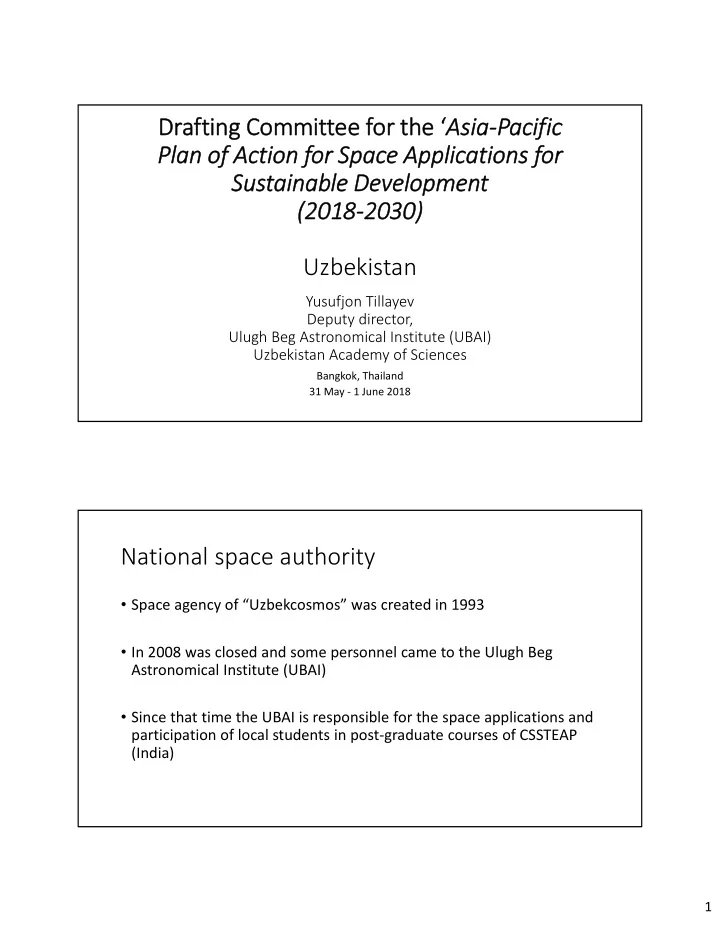

Dr Draftin ting Com Committee ee fo for the the ‘ Asia‐Pacific Plan of Action for Space Applications for Sustainable Development (2018‐2030) Uzbekistan Yusufjon Tillayev Deputy director, Ulugh Beg Astronomical Institute (UBAI) Uzbekistan Academy of Sciences Bangkok, Thailand 31 May ‐ 1 June 2018 National space authority • Space agency of “Uzbekcosmos” was created in 1993 • In 2008 was closed and some personnel came to the Ulugh Beg Astronomical Institute (UBAI) • Since that time the UBAI is responsible for the space applications and participation of local students in post ‐ graduate courses of CSSTEAP (India) 1
National space authority • In February of 2018, the President of Uzbekistan signed the decree about re ‐ establishment of the National Space authority “About measures on the development of space research and technologies in the Republic of Uzbekistan” • Goals • developing the national space science and • making extensive use of its achievements in the country's innovative development, • establishing and expanding international cooperation in the field of space research and • training qualified personnel in the aerospace industry The work in progress • Preparation of proposals for the development of space research and technology in the Republic of Uzbekistan • Studying the experience of developed countries in the space industry and technologies; • Comprehensive analysis of technical and economic parameters of projects for the implementation of space and satellite technologies 2
Expected results • A new department will be created in the Ministry for Development of Information Technologies and Communications of the Republic of Uzbekistan • This department will be the regulator of space technology development in Uzbekistan • A roadmap program of this organization includes • Ratification of UN conventions on space • Creation of space technology development conception • Preparation of the Uzbekistan law on space technologies • Extension of international cooperation, etc. Country Practices based on Priority Themes and Targeted Actions Provide examples of best practices and programmes using space applications for: • social development, • disaster risk reduction and resilience, • climate change, • management of natural resources, • connectivity, and • energy Reference document: Regional Road Map for Implementing the 2030 Agenda for Stainable Development in Asia and the Pacific 3
Examples: • National geodetic reference frame • Space monitoring of environment of Uzbekistan • GNSS meteorology implementation Current projects in Uzbeksitan GNSS (GFZ ‐ Potsdam, IGS, REGINA) DORIS (IDS) HYdroMET (GFZ, CAWa) 4
Monitoring of geodynamical Geodesy, cadastre destructive processes Monitoring of deformations of the earth's crust at short time intervals Local tie satellite images Space monitoring of environment of Uzbekistan 1. Glaciers monitoring in conditions of arid climate in Uzbekistan Data: • Landsat ‐ 4,5,7,8 (USGS) and ALOS (AVNIR ‐ 2, PRISM, PALSAR) (JAXA), • TerraSAR ‐ X/ TanDEM ‐ X (DLR); • GLAC / ICESat, • ASTER; Sentinel. 2. Monitoring of natural mountain hazards: ‐ ice ‐ dammed and rock ‐ dammed lakes; ‐ Debris flows, snow avalanches and landslides. 3. Monitoring of agricultural land: ‐ Assessment of soil moisture; ‐ Estimation of growth rate of vegetation; ‐ Forecast of productivity 4. Ecological monitoring of the Aral Sea area: ‐ transfer of harmful salts, ‐ crisis of the Aral Sea 5
Mountain area of Uzbekistan Урочище Чимган Перевал Камчик Identification of saline areas Supervised classification Classification using spectral libraries 6
Re Remote sensing sensing of of tr tropospheric opospheric water er abo above the the re region using using GNSS GNSS met meteor orology ology • Measurements of precipitable water vapour (PWV or TCW) in the troposphere above stations using the method of GPS meteorology. • Data from the permanent GPS ‐ stations installed at • Kitab (KIT3) • Tashkent (TASH) and • Maidanak is used for this analysis. • The stations were installed by GFZ ‐ Potsdam, Germany. Country Needs based on Priority Themes and Targeted Actions • Research and knowledge sharing: ‐ Satellite data (GNSS, imagery etc.) ‐ ‐ • Capacity building and technical support: ‐ Involving more students into trainings ‐ Special software for data processing ‐ ‐ 7
Space applications can be used in solving the following priority problems of the region • Aral sea vanishing • Desertification • Climate change • Water sharing • Thanks for your attention 8
Recommend
More recommend